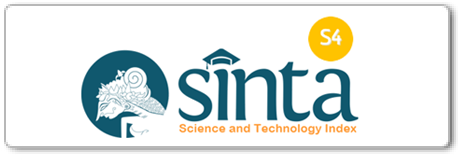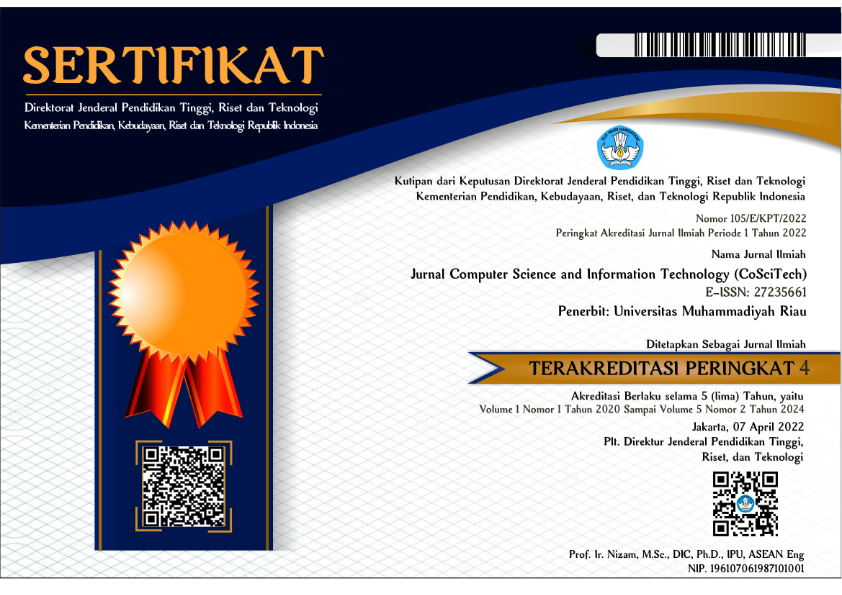Deep Learning untuk mendeteksi gangguan lambung melalui citra iris mata
DOI:
 https://doi.org/10.37859/coscitech.v4i3.6392
https://doi.org/10.37859/coscitech.v4i3.6392
Abstract
The stomach is one of the essential organs of the human digestive system. If the stomach organ cannot work typically, it will cause problems. This is a disease that occurs in the stomach organs. Gastric disease also occurs due to a lack of knowledge about stomach disease, so people ignore the symptoms that arise. Gastric disease is a disease that is considered very serious. If left alone, it can cause other diseases to occur. Generally, finding out the presence of stomach disease is still done manually, and several tests are carried out when stomach disease has recurred. Gastric disorders were classified using 360 iris images taken manually via a digital camera and a web database of iris images. The author used the Radial Basis Function Neural Network (RBFNN) method to classify iris images of patients with gastric disorders in this study. The results obtained from this research can organize the iris images of people with gastric disturbances. Classification of iris images of patients with gastric disorders achieved a training accuracy rate of 65.00%.
Downloads
References
[2] Edwin, K.R.R.W. (no date). ‘Penerapan Metode Learning Vector Quantization untuk Mendiagnosa Penyakit Gangguan Lambung’, Jurnal Telematika, 13(2).
[3] Fony, et all (2021). ‘Penerapan Augmented Reality Berbasis Android untuk Pembelajaran Organ Lambung Manusia ( Application of Android Based Augmented Reality for Human Stomach’, pp. 329–335.
[4] Kamilaris, A. and Prenafeta-boldú, F.X. (no date). ‘Deep Learning in Agriculture : A Survey’, pp. 1–53.
[5] Firdaus, Rahmad., Satria, Joni., and Baidarus. 2022. Klasifikasi Jenis Kelamin Berdasarkan Mata Dengan Menggunakan Algoritma Convolutional Neural Network (CNN). Jurnal Computer Science and Information Technology. 3, 267-273. https://doi.org/10.37859/coscitech.v3i3.4360.
[6] Phonna, K. and Khairil Simbolon, Z. (2020). ‘Deteksi Gangguan Lambung Melalui Citra Iris Mata Menggunakan Metode Jaringan Syaraf Tiruan Perceptron’, Jurnal Teknologi Rekayasa Informasi dan Komputer, 3, pp. 48–53.
[7] Rizki, Yoze., Hayami, Regiolina., Rahmadani, Elvina. 2022. Identifikasi Objek Cagar Budaya Candi Mahligai Berbasis Citra Menggunakan Mask R-CNN. Jurnal Computer Science and Information Technology. 3, 209-314. https://doi.org/10.37859/coscitech.v3i3.3939.
[8] Riezka (2016). ‘Deteksi Gangguan Lambung Melalui Citra Iris Mata Menggunakan Metode Jaringan Syaraf Tiruan Herbb Rule’, Infomedia, 1, pp. 44–47.
[9] Samsudin, R.I. (2018). ‘Penerapan Sistem Pakar Diagnosa Dini Penyakit Lambung Menggunakan Metode Forward Chaining’, Sistemasi, 7(1), pp. 30–37.
[10] Sandag, G.A. and Kaunang, F. (2019). ‘Klasifikasi Fungsi Family Protein Transport Menggunakan Radial Basis Neural Network’, CogITo Smart Journal, 5(2), p. 203. doi:10.31154/cogito.v5i2.191.203-214.














